Pairwise Coded mCAP with Chaotic Dual-Mode Index Modulation for Secure Bandlimited VLC Systems
Abstract
:1. Introduction
2. PWC-Based mCAP-DM with 2D Chaotic Encryption
2.1. Principle
2.2. DM with 2D Chaotic Encryption
2.3. PWC-Based mCAP
3. Results and Discussions
3.1. Simulation Results
3.2. Experimental Results
4. Conclusions
Author Contributions
Funding
Institutional Review Board Statement
Informed Consent Statement
Data Availability Statement
Acknowledgments
Conflicts of Interest
References
- Chi, N.; Zhou, Y.; Wei, Y.; Hu, F. Visible light communication in 6G: Advances, challenges, and prospects. IEEE Veh. Technol. Mag. 2020, 15, 93–102. [Google Scholar] [CrossRef]
- Chen, C.; Fu, S.; Jian, X.; Liu, M.; Deng, X.; Ding, Z.G. NOMA for energy-efficient LiFi-enabled bidirectional IoT communication. IEEE Trans. Commun. 2021, 69, 1693–1706. [Google Scholar] [CrossRef]
- Rajagopal, S.; Roberts, R.D.; Lim, S.K. Visible light communication: Modulation schemes and dimming support. IEEE Commun. Mag. 2012, 3, 72–82. [Google Scholar] [CrossRef]
- Minh, H.L.; Brien, D.O.; Faulkner, G.; Zeng, L.; Lee, K.; Jung, D.; Oh, Y. High-speed visible light communications using multiple-resonant equalization. IEEE Photonics Technol. Lett. 2008, 20, 1243–1245. [Google Scholar] [CrossRef] [Green Version]
- Chen, C.; Nie, Y.G.; Liu, M.; Du, Y.F.; Liu, R.S.; Wei, Z.X.; Fu, H.Y. Digital pre-equalization for OFDM-based VLC systems: Centralized or distributed? IEEE Photonics Technol. Lett. 2021, 33, 1081–1084. [Google Scholar] [CrossRef]
- Wu, F.M.; Lin, C.T.; Wei, C.C.; Chen, C.W.; Huang, H.-T.; Ho, C.-H. 1.1-Gb/s White-LED-based visible light communication employing carrier-less amplitude and phase modulation. IEEE Photonics Technol. Lett. 2012, 24, 1730–1732. [Google Scholar] [CrossRef] [Green Version]
- Chen, C.; Tang, Y.R.; Cai, Y.P.; Liu, M. Fairness-aware hybrid NOMA/OFDMA for bandlimited multi-user VLC systems. Opt. Express 2021, 29, 42265–42275. [Google Scholar] [CrossRef]
- Elgala, H.; Mesleh, R.; Haas, H. Indoor broadcasting via white LEDs and OFDM. IEEE Trans. Consum. Electron. 2009, 55, 1127–1134. [Google Scholar] [CrossRef]
- Chen, C.; Zhong, W.D.; Yang, H.L.; Du, P.F. On the performance of MIMO-NOMA based visible light communication systems. IEEE Photonics Technol. Lett. 2018, 30, 307–310. [Google Scholar] [CrossRef]
- Haigh, P.A.; Le, S.T.; Zvanovec, S.; Ghassemlooy, Z.; Luo, P.; Xu, T.; Chvojka, P.; Kanesan, T.; Giacoumidis, E.; Canyelles-Pericas, P.; et al. Multi-band carrier-less amplitude and phase modulation for bandlimited visible light communications systems. IEEE Wirel. Commun. 2015, 22, 46–53. [Google Scholar] [CrossRef]
- Akande, K.O.; Popoola, W.O. Subband index carrierless amplitude and phase modulation for optical communications. J. Lightwave Technol. 2018, 36, 4190–4197. [Google Scholar] [CrossRef] [Green Version]
- Wang, Z.; Zhang, J.W.; He, Z.X.; Zou, P.; Chi, N. Subcarrier index modulation super-Nyquist carrierless amplitude phase modulation for visible light communication systems. J. Lightwave Technol. 2021, 39, 6420–6433. [Google Scholar] [CrossRef]
- Hu, W.X.; Zhang, M.; Li, Z.; Popov, S.; Leeson, M.S.; Xu, T. High-dimensional feature based non-coherent detection for multi-intensity modulated ultraviolet communications. J. Lightwave Technol. 2021. [Google Scholar] [CrossRef]
- Zuo, T.; Wang, F.S.; Zhang, J.K. Sparsity signal detection for indoor GSSK-VLC system. IEEE Trans. Veh. Technol. 2021, 70, 12975–12984. [Google Scholar] [CrossRef]
- He, J.; He, J.; Shi, J. An enhanced adaptive scheme with pairwise coding for OFDM-VLC system. IEEE Photonics Technol. Lett 2018, 30, 1254–1257. [Google Scholar] [CrossRef]
- Yang, Y.B.; Chen, C.; Zhang, W.; Deng, X.; Du, P.F.; Yang, H.L.; Zhong, W.D.; Chen, L.Y. Secure and private NOMA VLC using OFDM with two-level chaotic encryption. Opt. Express 2018, 26, 34031–34042. [Google Scholar] [CrossRef] [PubMed] [Green Version]
- Kordov, K.; Stoyanov, B. Least significant bit steganography using Hitzl-Zele chaotic map. Int. J. Electron. Telecommun. 2017, 63, 417–422. [Google Scholar] [CrossRef] [Green Version]
- Chen, C.; Nie, Y.G.; Ahmed, F.; Zeng, Z.H.; Liu, M. On the Constellation Design of DFT-S-OFDM with Dual-Mode Index Modulation in VLC. 2022. Available online: https://www.researchgate.net/publication/357747021_On_the_constellation_design_of_DFT-S-OFDM_with_dual-mode_index_modulation_in_VLC (accessed on 11 February 2022).
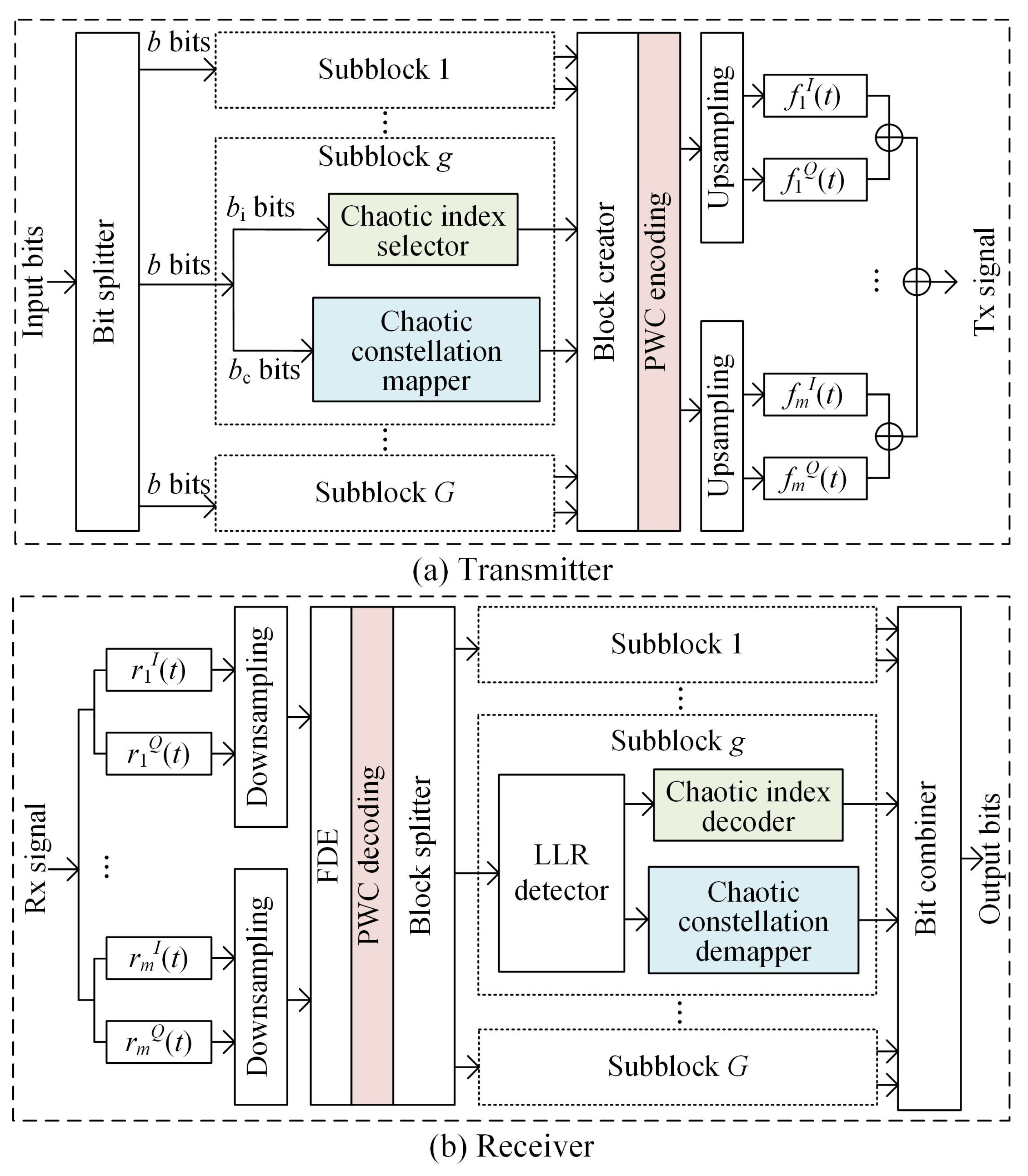

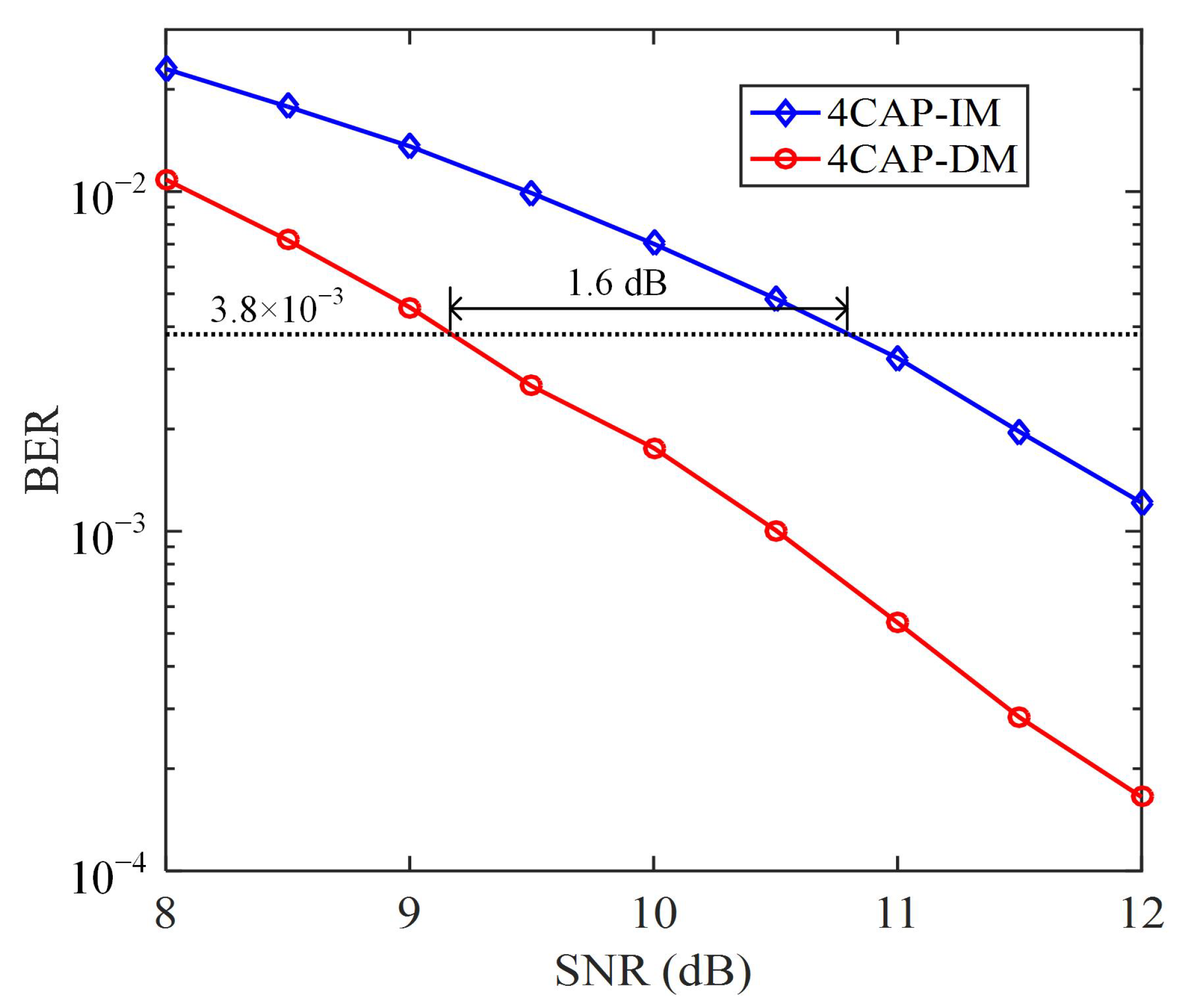
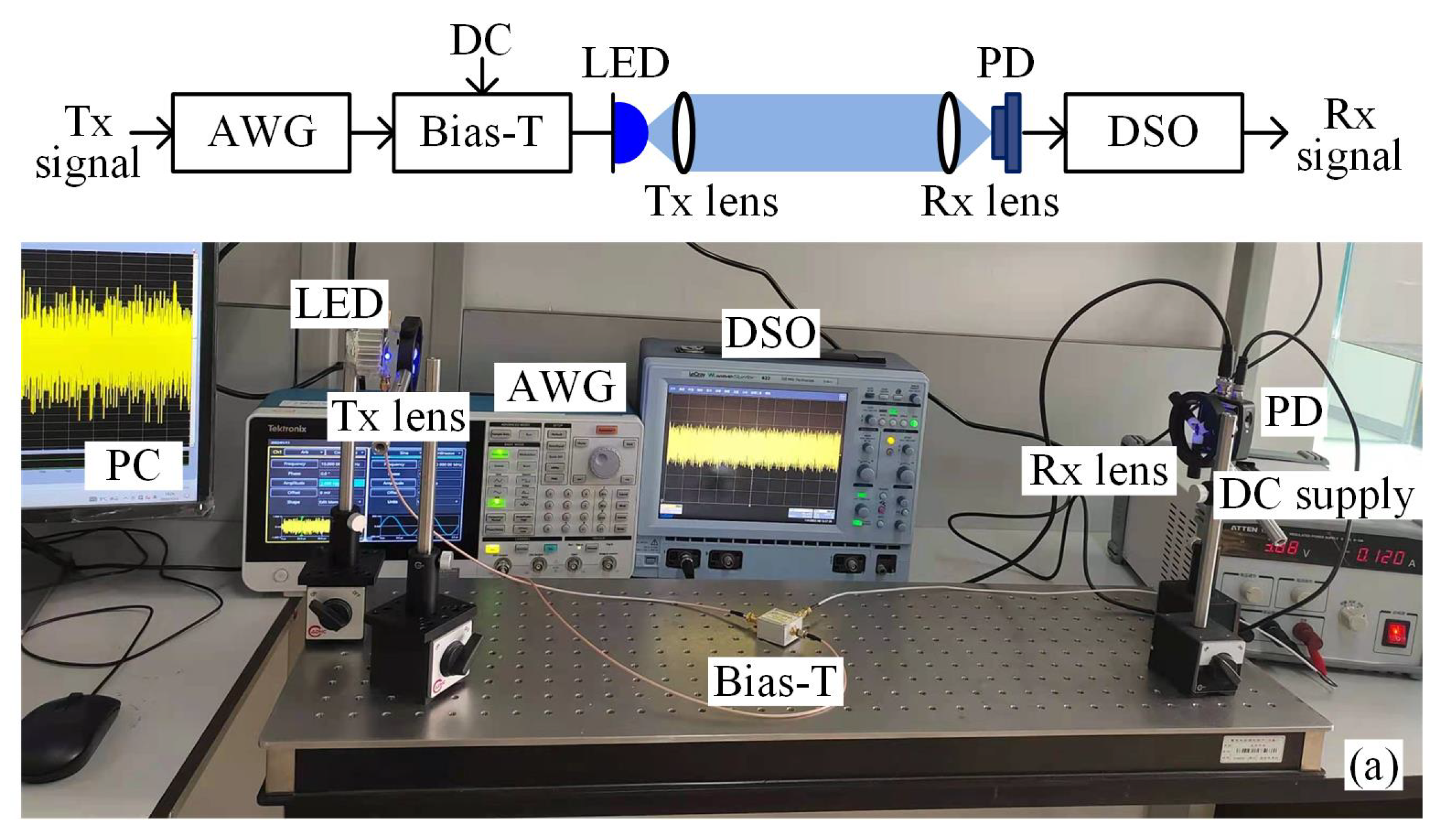
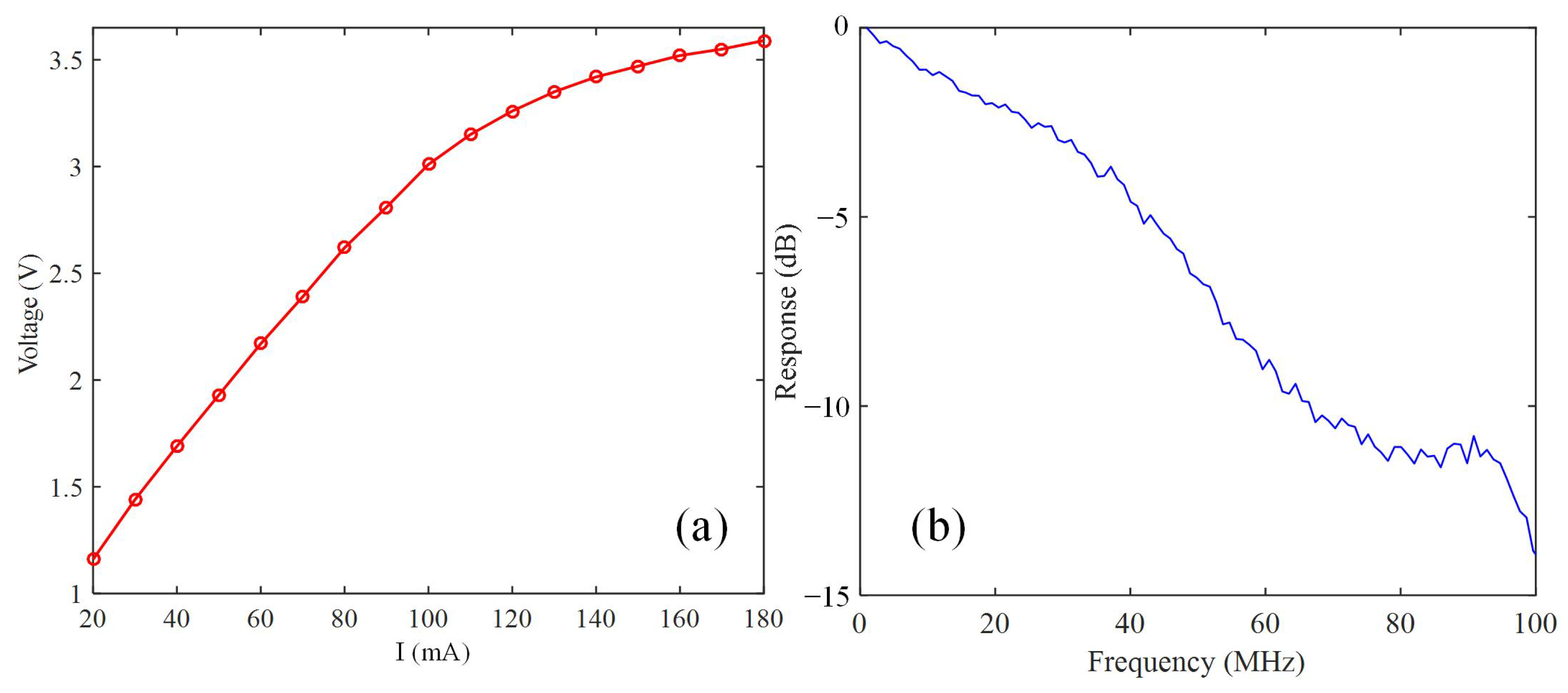
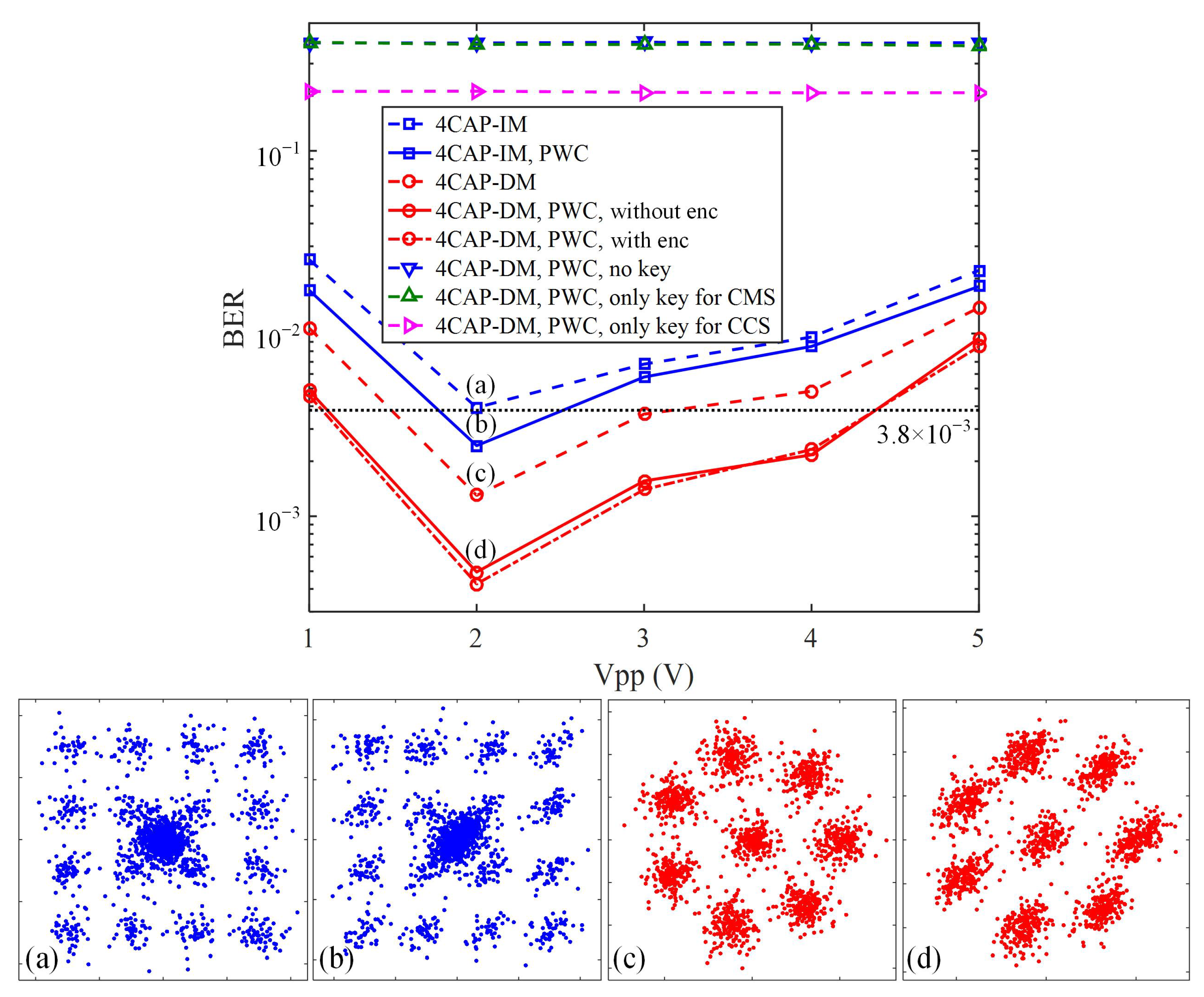
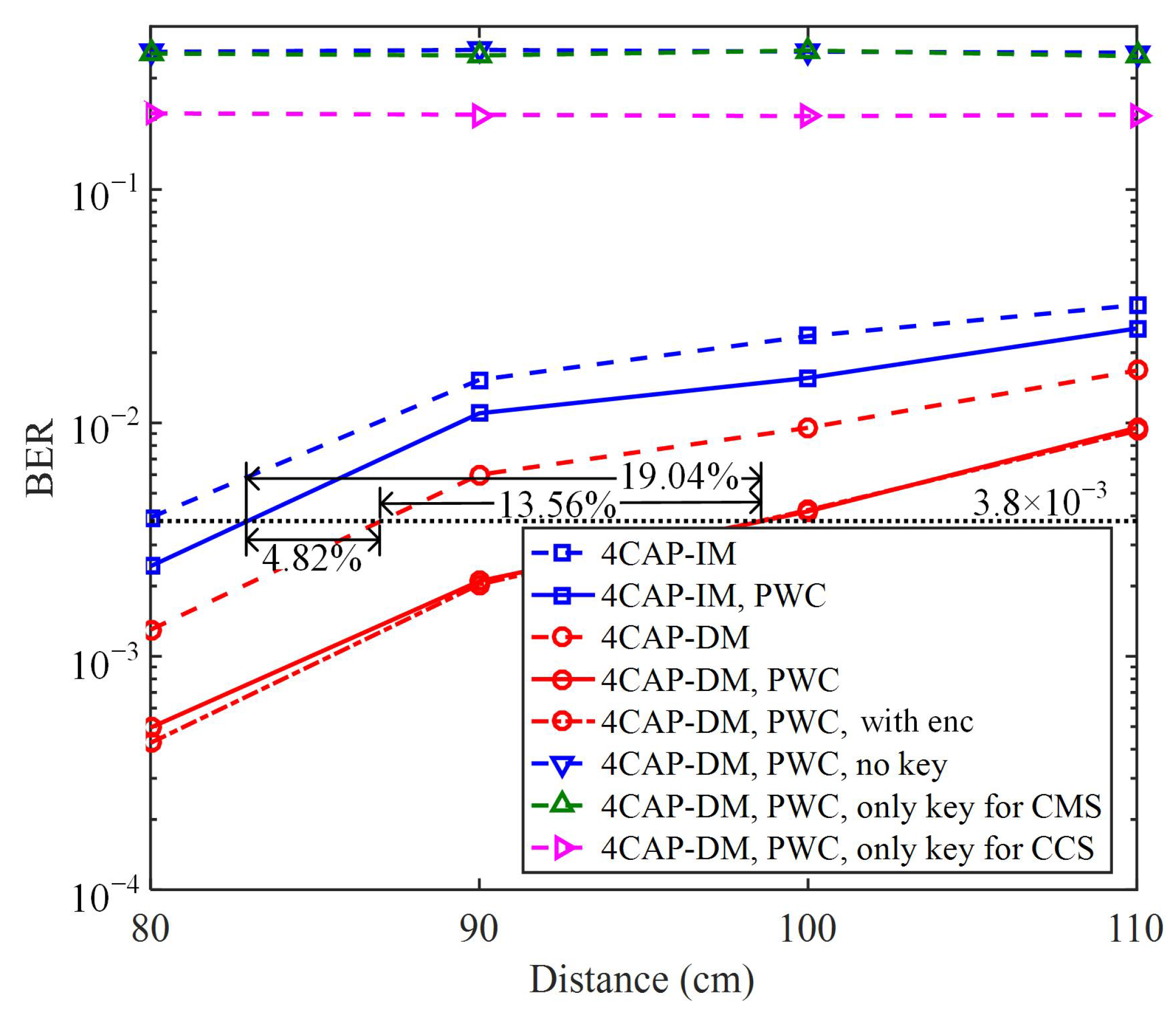
| = 0 | = 1 | |
|---|---|---|
| Mode 1 | ||
| Mode 2 |
| Parameter | Value |
|---|---|
| Number of subbands (m) | 4 |
| Number of subbands in each subblock (N) | 2 |
| Number of activated subbands in each subblock (k) | 1 |
| Roll-off factor of RRCF | 0.15 |
| Upsampling factor | 12 |
| Spectral efficiency (SE) | 2.5 bits/s/Hz |
| Simulation channel | AWGN |
| Parameter | Value |
|---|---|
| AWG sampling rate | 250 MSa/s |
| Signal bandwidth | 96 MHz |
| DC bias current | 120 mA |
| Diameter of biconvex lenses | 12.7 mm |
| Focal length of biconvex lenses | 20 mm |
| Bandwidth of PD | 150 MHz |
| Active area of PD | 0.8 |
| DSO sampling rate | 1 GSa/s |
Publisher’s Note: MDPI stays neutral with regard to jurisdictional claims in published maps and institutional affiliations. |
© 2022 by the authors. Licensee MDPI, Basel, Switzerland. This article is an open access article distributed under the terms and conditions of the Creative Commons Attribution (CC BY) license (https://creativecommons.org/licenses/by/4.0/).
Share and Cite
Nie, Y.; Zhang, W.; Yang, Y.; Deng, X.; Liu, M.; Chen, C. Pairwise Coded mCAP with Chaotic Dual-Mode Index Modulation for Secure Bandlimited VLC Systems. Photonics 2022, 9, 141. https://doi.org/10.3390/photonics9030141
Nie Y, Zhang W, Yang Y, Deng X, Liu M, Chen C. Pairwise Coded mCAP with Chaotic Dual-Mode Index Modulation for Secure Bandlimited VLC Systems. Photonics. 2022; 9(3):141. https://doi.org/10.3390/photonics9030141
Chicago/Turabian StyleNie, Yungui, Wei Zhang, Yanbing Yang, Xiong Deng, Min Liu, and Chen Chen. 2022. "Pairwise Coded mCAP with Chaotic Dual-Mode Index Modulation for Secure Bandlimited VLC Systems" Photonics 9, no. 3: 141. https://doi.org/10.3390/photonics9030141
APA StyleNie, Y., Zhang, W., Yang, Y., Deng, X., Liu, M., & Chen, C. (2022). Pairwise Coded mCAP with Chaotic Dual-Mode Index Modulation for Secure Bandlimited VLC Systems. Photonics, 9(3), 141. https://doi.org/10.3390/photonics9030141







